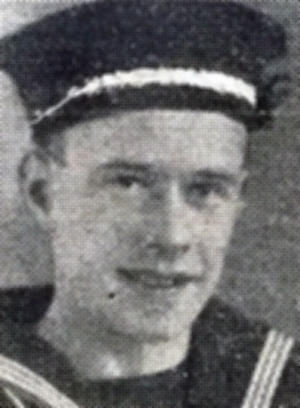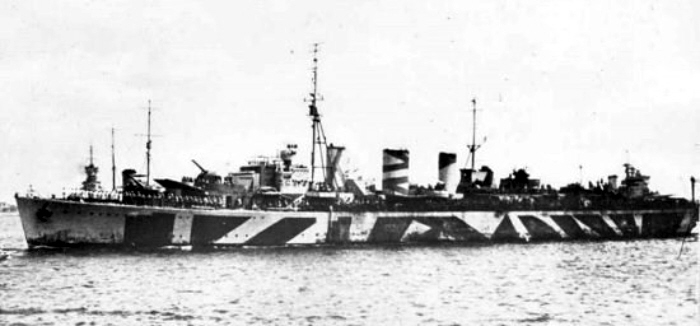
Gilbert B. Hepworth was born in Ossett in early 1918, the son of Harry Hirst Hepworth and Beatrice Hepworth (nee Barrowcliffe), of Ossett, Yorkshire. Harry and Beatrice had married in Ossett in 1914.
HMS ‘Welshman’ was was an Abdiel-class minelayer of the Royal Navy. During World War II she served with the Home Fleet carrying out mine laying operations, before being transferred to the Mediterranean Fleet in mid-1942 for the Malta Convoys. Welshman supported the island of Malta during the long siege in WW2. The island population resisted strongly and was collectively awarded the highest decoration for civilian bravery. Welshman brought food and essential supplies many times; her role was featured in the UK movie “The Malta Story.”
When unloading in Valetta harbour she was attacked and suffered a near miss which damaged her prop shafts, putting one of her three engines out of service. As her principal fighting strength was her extreme speed this damage affected her ability to perform drastically. She was also torpedoed subsequently, but made it home to the United Kingdom and was repaired at Devonport. She returned to the Mediterranean to serve on the same relief duty, steaming under disguise and simulating French warships.
On the 1st February 1943, HMS ‘Welshman’ (Capt. William Howard Dennis Friedberger, DSO, RN) was returning from Malta to Alexandria when she was sunk about 45 nautical miles east-north-east off Tobruk, Libya in position 32º12’N, 24º52’E, by two torpedoes from the German submarine U-617 commanded by Albrecht Brandi, with the loss of 157 lives. U-617 fired a spread of four torpedoes at HMS ‘Welshman’ and observed two hits and a boiler explosion. The ship capsized and sank by the stern after two hours. The survivors were rescued by destroyers Tetcott and Belvoir and taken to Alexandria in Egypt.
U-617 ran aground west of Cape Tres Forcas, near Melilla, Spanish Morocco on the 12th September 1943, after a sustained air depth charge attack by RAF Wellington bombers from 179 Squadron. All 49 crew members were able to evacuate the stricken submarine, and were subsequently interned by the Spanish authorities. They were later repatriated to Germany. The abandoned submarine was then finished off with combined RAF Hudson and FAA Swordfish aircraft from Gibraltar plus gunfire from HMS ‘Hyacinth’ and HMAS ‘Wollongong’.
The “Ossett Observer” had this short obituary for Gilbert B. Hepworth:1
“Missing Ossett Naval Rating – Recently we announced that a letter had been received by Mr. and Mrs. Hepworth, 5, Hill Crest Avenue, Ossett intimating that their son Gilbert, who was in the Royal Navy, had been reported “Missing, presumed killed” on February 18th. Young Hepworth, who would have been 25 years of age on February 18th, was previously in the service of the butchering department of Ossett Co-Operative Society. He was a very valued and esteemed employee, and his colleagues, who in their affection for him, have desired the publication of the accompanying photograph (above), have received letters from the family thanking them for their enquiries and sympathy in their great anxiety. His many friends are still hopeful of better news in the future.”
An earlier “Ossett Observer” report had this note about him being missing:2
“Ossett Naval Rating Missing – Member Of The Co-Operative Staff – Mr. H. Hepworth, hairdresser, Dale Street, Ossett, who resides at 5, Hill Crest Avenue, Leeds Road End, has received a letter from the Admiralty, announcing that his son Gilbert, who was serving in the Royal Navy had been reported “missing, presumed killed” on February 1st. He was educated at Gawthorpe School and after working for a short time at Dewsbury, entered the service of the central butchery department of Ossett Co-Operative Society as an improver, in February 1937. For some time before joining the Royal Navy in 1940, he went round with the meat van. Uniformly courteous and conscientious in the discharge of his duties, he was held in the highest esteem by his employers and the public generally. The deepest sympathy goes out to the parents in their great anxiety.”
Able Seaman Gilbert B. Hepworth was one of the 157 men who died on the 1st February 1943 with the sinking of HMS Welshman, aged 24 years and is remembered on Panel 69.1 at the Chatham Naval Memorial. After the First World War, an appropriate way had to be found of commemorating those members of the Royal Navy who had no known grave, the majority of deaths having occurred at sea where no permanent memorial could be provided.

Above: HMS Welshman in 1942.
An Admiralty committee recommended that the three manning ports in Great Britain – Chatham, Plymouth and Portsmouth – should each have an identical memorial of unmistakable naval form, an obelisk, which would serve as a leading mark for shipping. The memorials were designed by Sir Robert Lorimer, who had already carried out a considerable amount of work for the Commission, with sculpture by Henry Poole. The Chatham Naval Memorial was unveiled by the Prince of Wales (the future King Edward VIII) on 26 April 1924.
After the Second World War it was decided that the naval memorials should be extended to provide space for commemorating the naval dead without graves of that war, but since the three sites were dissimilar, a different architectural treatment was required for each. The architect for the Second World War extension at Chatham was Sir Edward Maufe (who also designed the Air Forces memorial at Runnymede) and the additional sculpture was by Charles Wheeler and William McMillan. The Extension was unveiled by the Duke of Edinburgh on 15 October 1952.
Chatham Naval Memorial commemorates 8,517 sailors of the First World War and 10,098 of the Second World War.3
References:
1. “Ossett Observer”, Saturday, March 6th 1943.
2. “Ossett Observer”, Saturday, February 20th 1943.